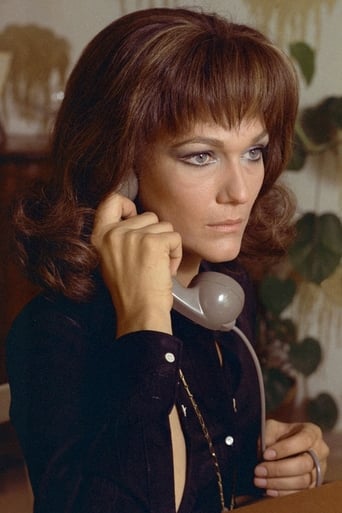Dirtylogy
It's funny, it's tense, it features two great performances from two actors and the director expertly creates a web of odd tension where you actually don't know what is happening for the majority of the run time.
ofumalow
I got led to this by "Godard Mon Amour," in which a divide between the dramatized Godard and Anne W. is heightened by her accepting the lead in this film after Ferrari agrees that she won't have to appear nude at all, let alone throughout. (Neither lead does, so either that was an invention of "Mon Amour," or Ferreri radically changed his concept before filming.) Anyway, it's an interesting, rather typical European arthouse experiment of the counterculture era. The leads are a modern Adam & Eve left alone in a well-supplied beach house after they survive a murky apocalyptic incident that apparently kills off most of mankind. (They seem to have survived by driving through a long tunnel when "it" hit.) But this Eve doesn't want to re-populate the Earth by giving birth in such a bleak environment. The only thing that "happens" after the start is the eventual arrival of Annie Girardot as an older woman a little too eager to fill the sexuality/pregnancy gap with our virile young hero, and whose competitiveness towards the heroine leads toward the movie's one violent act. "The Seed of Man," which I could only find in Italian without English subtitles (I understand some Italian, but this isn't a movie where the dialogue is terribly important), is typical of many Ferreri films: Striking in concept, middling in execution. It's lively enough considering that not much "happens," and the leads are agreeable, but there are too many scenes of them simply gamboling about, and the bemused, leisurely tenor isn't close enough to either satire or tragedy for the overall sociopolitical commentary to have any great impact. Still, it's a quirky movie from an always-interesting (at least in theory if not always practice) filmmaker, and if like me you get a kick out of such late 60s/early 70s projects that no one in their right mind would have funded at any other moment in time, "Seed" is certainly worth a look.
duke1029
Marco Ferreri was one of the most fiercely independent and brashly challenging directors in world cinema with strong radical views on relationships between the individual and society. He purposely does not try to make his often undisciplined work easily accessible and deliberately challenges his audience to interpret his uniquely personal vision. Only those who have an affinity for his acerbic humor, confusing, often meandering, plot lines. and surreal, obscure symbolism can expect to leave a Ferreri film feeling fulfilled.Post-apocalyptic visions about survivors of some worldwide holocaust have been a sub-genre in movie science fiction since Arch Oboler's "Five" in 1951, the story of five survivors of a nuclear holocaust. The aftermath of nuclear war seems to have been a favorite for filmmakers although other Doomsday scenarios have branched out to such varied global cataclysms as a new ice age, global warming, a destructive plant virus, a rogue comet, and unspecified government research projects. Ferreri chooses a strain of the Plague, more virulent than anything previously seen although there are no scenes of mass death or suffering seen anywhere in the movie. This Post-Apocalyptic landscape genre provides the wildly idiosyncratic Ferrreri with a wide canvas on which to include his Daliesque imagery and extravagantly baroque metaphors. Whether you consider him a neglected genius or a self-indulgent poseur, no one can accuse him of being dull. I think both his supporters and detractors would agree that he is definitely an acquired taste. We first meet Cino and Dora dining casually with other travelers in an airport tourist market. We are notified of the threat of worldwide plague on the oversize TV in the restaurant area, but the visuals consist only of archival b/w footage of panicked crowds and burned-out cities with some Vietnam-era helicopter shots thrown in for good measure. Nothing of current "plague" is seen, and all those in this duty-free facility seem to be indifferently conducting business as usual, oblivious to the crisis.When Cino and Dora come across a school-bus on a deserted highway with a dead driver and passengers, none shows any sign of any disease, least of all the black pustules characteristic of the Plague. Shortly thereafter the couple is overtaken by a helicopter and brought to a makeshift quasi-military command post. It is sparsely populated and the main structure is a clear plastic cylindrical dome. A medic is inside administering oxygen to an apparently dead woman although the cause of her death, as well as the child beside her, seems to be a slit throat. They are then wrapped in aluminum foil and their bodies are laid with others in an open field, where the corpses are incinerated with a napalm flamethrower. After a few perfunctory questions to Dora about the status of her relationship with Cino, they are released after being given a single "magic bullet" pill that will keep them free from plague and other diseases for six months. The leader obviously feels sympathy for Dora as he rebuffs his subordinate's suggestion that the young couple be summarily executed. He cautions them that the plague has become much worse, and they should not leave the area. He instructs her to find a nearby house, presumably abandoned, and avoid other people indefinitely.They find an unusual stone house on the beach with its dead taxidermist owner (director Ferreri in a cameo) sitting on the porch and decide to make this their new home. Thinking of posterity, Cino decides to convert the house into a museum with himself as curator. His first exhibit is an improbable giant wheel of Parmesan cheese. The other objects he catalogs are mundane and kitschy artifacts from common life including a View-Master stereoscopic viewer replete with scenes of New York, a frequent Ferreri bete noir.After Ferreri's body disappears without explanation, a caricature of him with his signature chin strap beard is hung on the wall. In fact, Cino begins to grow his own chin strap beard as he displaces the owner and sets up housekeeping. It seems obvious that the "plague" that is decimating civilization is a allegorical, not pathological, one. Depending on one's interpretation, this "plague" is a parable for society's repression of individuality, crass commercialism, and crushing conformity.The Post-Apocalyptic science fiction genre allows Ferreri to create a surreal environment in which anything is possible, and he is free to populate the landscape with his wildly free-wheeling images: a group of black-shirted neo-fascist horsemen whose androgynous leader makes the couple sign a pledge in blood that they will procreate, a zeppelin-like balloon that Dora hopes will rescue them but is in reality an American Pepsi-Cola blimp, and the rotting carcass of Moby Dick that washes up on the beach. Besides these more obvious symbols there are small throwaways like Ferrari's signature red gun, a recurring artifact that appears in other of his films and an incongruous American gum dispenser at the military base. Even the most ardent Ferreri fan will find it difficult to connect the dots between the film's cognitive and personal metaphors. (e.g. the TV announcer declaring that the color yellow will be used as code for the plague and Dora's choice of "Brooklyn" yellow gum from the dispenser.)After Dora decides she does not wish to bring a child into such a world, an attractive middle-aged French woman appears to insinuate herself into the household and promptly seduces Cino, eager to bear his child. When she later tries to usurp Dora's position by murdering her, Dora turns the tables on the interloper and beats her to death, cooking and serving up her leg to Cino as what she characterizes as a "mystery" meat." The plot by this time is by no means resolved, but if you're still watching the film by this time, you've realized that watching Ferreri's movies is, like "mystery meat," an acquired taste.
Lee Eisenberg
Marco Ferreri's surreal film "Il seme dell'uomo" ("The Seed of Man" in English) looks more plausible today than it probably did when it first came out. The movie portrays a young man and woman who, after learning of a plague ravaging the populace, take refuge in a house on the coast and turn it into a miniature museum displaying cultural relics from the days before the plague. But that's not the end...An interesting point is that the movie never identifies what the plague in question is specifically. It could be any scourge. Certainly plenty of bad things have afflicted the planet recently - the combination of global warming and the financial crisis constitutes a perfect storm - to the point that the events portrayed in this movie look as though they could come true. I bet that Marco Ferreri never realized what a prescient movie he was making! So, I recommend this. Not just as a warning about what the world could turn into, but as a look at Italy's changing cinema in the late '60s (in which Ferreri played a major role). Definitely worth seeing.



